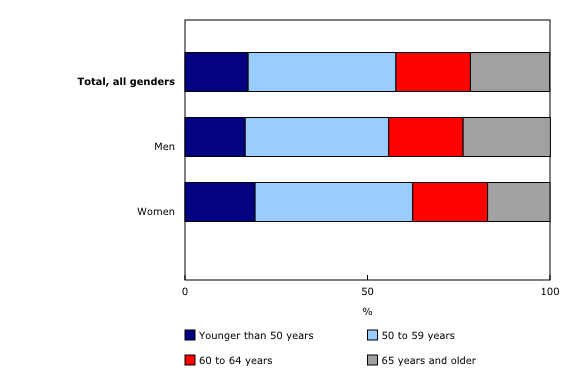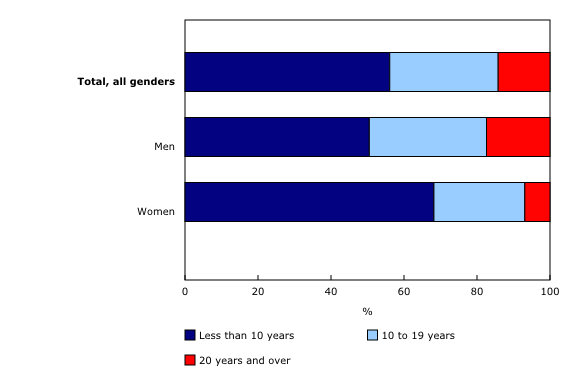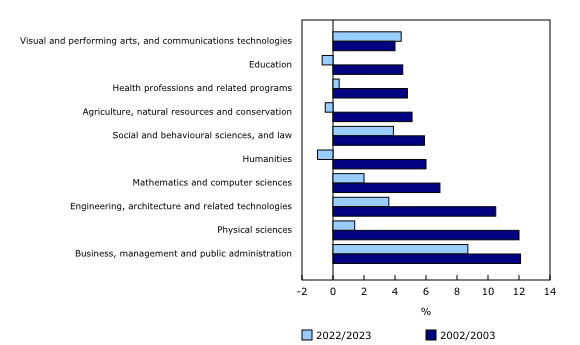Number and salaries of full-time teaching staff at Canadian universities, 2022/2023
Released: 2023-11-01
In 2022/2023, there were 48,258 full-time teaching staff at Canadian universities, an increase of 33.9% since 2002/2003. Among them, over one-third (36.7% or 17,718) were full professors, the highest rank a professor can achieve.
Achieving this academic rank can be a significant career goal. It is also associated with job security, tenure, academic freedom, and the opportunity to shape and contribute to a field of knowledge. This Daily article presents a short profile of full professors by examining their key characteristics over the past 20 years.
Although there were more full professors in 2022/2023 than 20 years earlier, their share has declined slightly over time, from 38.6% in 2002/2003 to 36.7% in 2022/2023. While the proportion of full professors who are women has nearly doubled over these two decades, men are still over-represented at this rank.
Proportion of full professors aged 65 years and older continues to increase
In 2002/2003, 3.9% of full professors were aged 65 years and older, compared with 21.7% in 2022/2023. This rapid increase coincided with the end of mandatory retirement legislation that occurred in most provinces in the mid-2000s. In 2022/2023, among full professors, there were proportionally more women (19.2%) than men (16.5%) aged younger than 50 years. However, the share of men aged 65 years and older (23.9%) among full professors was greater than that of women (17.1%). Yet, this proportion grew faster for women than for men, as it was 2.0% for women and 4.2% for men in 2002/2003.
Proportion of full professors who are women has increased but has not reached parity
Women have increased their representation among full-time teaching staff at Canadian universities at all ranks, including that of full professor. Despite these gains, the largest representation gap remained among full professors, as 3 in 10 of them (32.2%) were women in 2022/2023. Notably, their representation has nearly doubled from 17.2% in 2002/2003.
Among full professors, men have more years at rank than women
The number of years that a professor has held their current rank is an indicator of their experience that is likely to affect their annual earnings. In 2022/2023, men had, on average, 11.1 years of experience at the rank of full professor, while women had 7.6 years of experience. Overall, in 2022/2023, 56.1% of full professors had been at this rank for less than 10 years, 29.7% had been full professors for 10 to 19 years, and 14.2% had been at this rank for 20 years and over. Among those who had been at this rank for 20 years and over, women (6.9%) were underrepresented compared with men (17.4%). Of all the full professors who had been at this rank for 20 years and over, 83.3% were men.
Among full professors, men earn more than women
Full professors who are men ($179,175) had a higher median salary in 2022/2023 than their women counterparts ($172,525). Salaries for full professors ranged from $143,400 (10th percentile) to $230,925 (90th percentile). These salary ranges were slightly larger for men than for women, with men earning $145,200 to $235,550 and women earning $141,175 to $221,400. The maximum salary (90th percentile) for men exceeded that for women at the same rank by 6.4%, or $14,150.
In addition to the over-representation of men in the older age group and their longer average time spent at rank, another factor that can affect differences in median salaries is the market adjustments that certain academics negotiate with their institutions. While these adjustments are included in the salaries of full professors collected as part of this survey, the value of these adjustments cannot be isolated. Some research suggests that, for full professors, having a family may limit a woman's ability to negotiate during hiring, which is known as "intrafamily bargaining."
Gender pay gap among full professors is closing
The gender pay gap is the difference between women's and men's median earnings relative to the median earnings of men. A positive value indicates that men earn more than women. A negative value indicates that women earn more than men. Not accounting for age or time spent at rank, the gender pay gap for full professors continued to narrow over the past two decades, declining from 7.0% in 2002/2003 to 3.7% in 2022/2023. (For information on the different methods used to calculate the gender pay gap, please see Measuring and Analyzing the Gender Pay Gap: A Conceptual and Methodological Overview and The gender wage gap in Canada: 1998 to 2018).
Over the past 20 years, the gender pay gap at the rank of full professor has narrowed across all fields, although not at the same rate. In 2022/2023, women had higher median earnings than men in humanities (-1.0%); education (-0.7%); and agriculture, natural resources and conservation (-0.5%). This reflects an evolving gender pay gap pattern.
Progress has also been made in closing the gender pay gap in fields where full professors who are men earned more than those who are women. Since 2002/2003, progress has been made in the health professions and related programs (from 4.8% to 0.4%), physical sciences (from 12.0% to 1.4%) and mathematics and computer sciences (6.9% to 2.0%) fields.
In 2002/2003, the gender pay gap was highest in business, management and public administration, at 12.1%, and remained the highest in 2022/2023, at 8.7%. In this field, the maximum salary (90th percentile) was $312,975 for men compared with $261,050 for women. The difference between the 90th percentile earnings of men and women was $51,925, which is more than three times the difference for all fields combined ($14,150).
Note to readers
The University and College Academic Staff System - Full-time Staff provides Canadians with a detailed portrait of full-time academic staff in Canadian universities. This includes gender, year of birth, year at rank, principal subject taught, academic rank, salary and administrative stipends, administrative responsibilities, previous employment, and province or country of degrees earned.
For 2022/2023, data for some institutions were estimated based on the previous year's data, as these institutions were unable to submit data before the deadline for various reasons. This information will be updated once the transition is complete and final salaries are submitted to Statistics Canada.
The gender pay gap is the difference between the median employment earnings of women and men, expressed as a proportion of men's earnings (i.e., the "gender pay ratio"). Alternatively, the gender pay ratio can be subtracted from one and multiplied by 100, such that it represents the difference in percentage terms. A positive value indicates that men earn more than women. A negative value indicates that women earn more than men.
The calculation of the gender pay gap used in this analysis is based on the median annual rate of salary plus stipends (1- (women's median salary/men's median salary) x 100) for full professors. In the calculation of median salaries, deans and directors equivalent to deans, staff on unpaid leave, staff with no salary and staff with a lower salary scale than regular scales are excluded.
Products
The interactive data visualization tool "Statistics on full-time academic teaching staff at Canadian universities: Interactive tool" (71-607-X) is available
Contact information
For more information, or to enquire about the concepts, methods or data quality of this release, contact us (toll-free 1-800-263-1136; 514-283-8300; infostats@statcan.gc.ca) or Media Relations (statcan.mediahotline-ligneinfomedias.statcan@statcan.gc.ca).
- Date modified:



